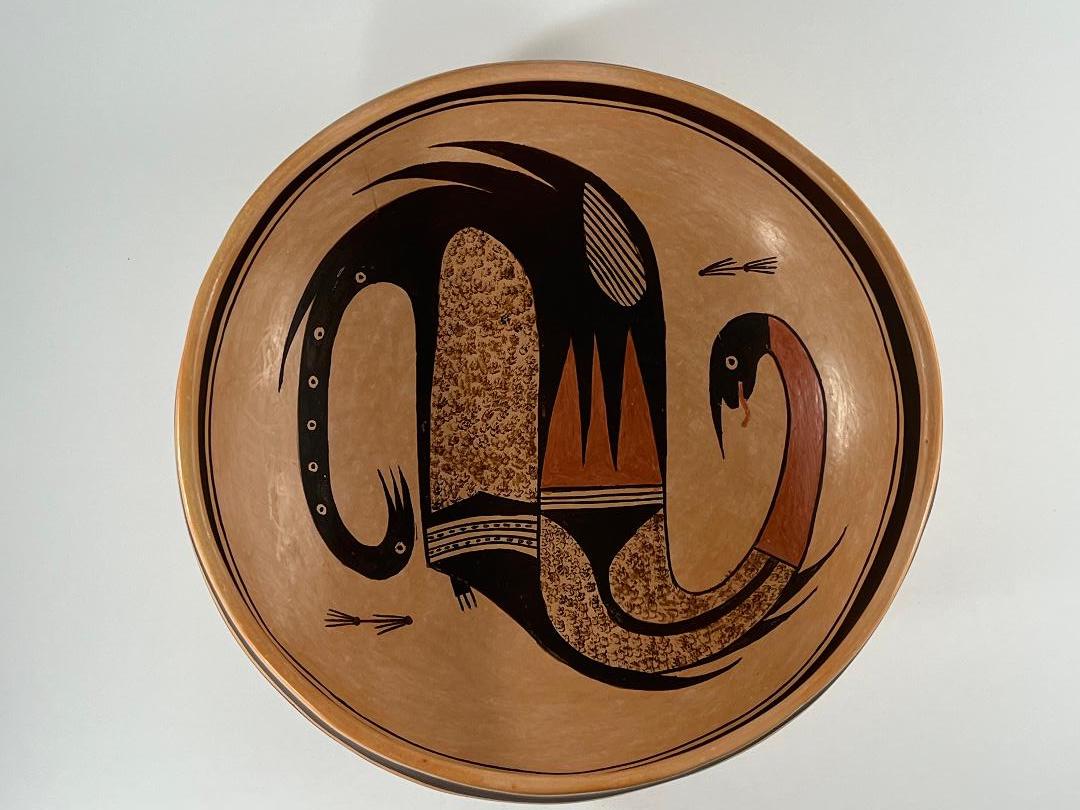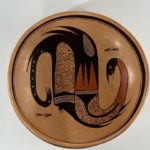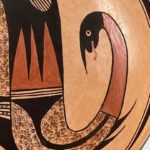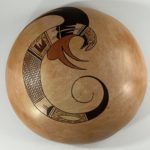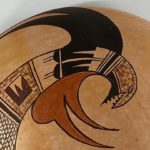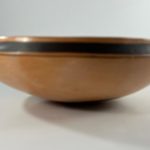This bowl began as an attempt to depict clearly the design on a faded Nampeyo bowl, then a second design from an ancient Sikyatki bowl was added, and thus the bowl displays designs on both the interior and the exterior.
Rachael Sahmie made the bowl at my request, and that request has its origin in a Nampeyo bowl that is part of this collection (2020-11). That bowl depicts the mythic creature Um-tok-ina, the Thunderer. The design on the bowl is very faded, but is intact:

Bowl 2020-11
The catalog entry for bowl 2020-11 has a detailed verbal description of the design, as best I can see it. In order to have a clearer visual depiction of the design, I sent Rachael photographs of the Nampeyo bowl and my written description and asked her if she could recreated the design. She thought she could.
Steve Elmore shared a photograph of an ancient Sikyatki bowl with Rachael. The interior of the bowl carried a complicated serpent design and Rachael made a bowl with this design for Steve. I expressed my admiration of this design to Rachael. We talked, and eventually the Nampeyo serpent became the exterior design and the creatures on the ancient Sikyatki bowl became the interior design of bowl 2021-21.
The Sikyatki design on the interior of bowl 2021-21 is clearly reptilian With a quick look the design is difficult to disentangle. Do reptiles blush? A more studied look reveals this design as two reptiles, male and female, having an intimate moment. Far more than most pottery designs, the details are specific and —I think— intentional.
Bowl 2021-21 is unsigned because three serpents demand a lot of living area.
There’s the old saw that if you have three examples of a particular item, the group qualifies as “a collection.” Bowl 2021-21 is thus a collection of serpents, which ought to be fearsome but turns out to be engaging.
Form:
Bowl 2121-21 has a rounded bottom that curves upward for about 5.75 inches to an everted rim 0.875-inches tall. The span of the convex bottom is 11.5 inches, the surface on which Nampeyo’s serpent is painted. The sides are even and substantial but not thick. The bowl is evenly blushed from its outdoor firing, with a few slightly darker blushes on the exterior.
Interior design:
At first look the interior design looks like an odd creature with a clearly-defined head, a enlarged body, and a black tail. Notice that the head and the black tail have roughly the same shape and both have eyes. Eyes on a tail?…..And what was seen as a tail resolves itself into a second head, which means that that enlarged body in the center of the design is really two bodies together, which suggests….reproduction. To fit this image into a space 9.5 inches in diameter, the interior design makes four 180-degree turns. Uncoiled, the image would be 21.5-inches long.
One of the two serpents displays both red and black paint. The other is monochromatic. Following the example of mallard ducks and cardinals, I believe that the more colorful creature is male and the monochromatic creature is female.
The male:
The black head carries a forward-thrusting horn, a partially-open mouth and a thin red tongue testing the air outside. To help orient the design, I will call the direction the head is pointing “down.”
A 3.26-inch long slightly-curved red neck supports the head. Following the neck is a 4.25-inch long curved section marking the beginning of the torso, the end near the neck being about half as wide as the far end. Against the far wall is an isosceles triangle pointed “down” with slightly concave sides. At its peak a long stem emerges and follows the curve of this section back to the base of the red neck. The remaining area of this section is stippled. Following are four parallel lines, a three-lane “highway.”
The torso continues with a grouping of three conjoint red triangles that share a common base against the three-lane highway and point “up.” The three upward-facing red triangles define four reciprocal black triangles that point “down.” The two central black triangles are isosceles while the flanking triangles are right triangles. The wide black section continues for another 2-inches, this stretch being interrupted by a large unpainted drop shape enclosing 9 parallel lines. The three exterior fins that emerge past this drop shape mark the rear of the male serpent.
The female:
Beginning at the other end of the design, the head of the female serpent is in the form of three conjoint triangles set just in front of a circular eye and is pointed “up.” The long neck of the creature displays six additional circular elements, these I assume are markings and not eyes. Just past the last of these circular elements the female body widens and then separates into two thin blades. The left blade abruptly drops “down” parallel to the neck. As the female body begins to become narrower, it arches and then drops the second blade parallel to, but 1.5 inches from, the first blade. Between them the two blades define a large bullet-shaped area that is stippled.
The base of this stippled element is plugged by a wide isosceles triangle, its point “up.” Below its base are six parallel lines forming a five-lane “highway.” The first, middle and last lanes remain uncluttered, but the second and fourth lanes contain 10 or 11 dots. Below this highway is a long element with a broad hatched-shaped head against the highway and a tapered, skewed tail that extends towards the head of the male serpent. As it narrows, three fins emerge from the tail, marking the rear of the female serpent. Note that a small tubular element with three short parallel hairs emerges from the outer edge of hatchet head.
Exterior design:
As noted above, the design on Nampeyo’s bowl 2020-11 is intact, but faded. At my request Rachael copied the design from 2020-11 onto the exterior of bowl 2021-21 so that Nampeyo’s serpent could be clearly seen. The elements of design on the two bowls are the same, so I will not provide a detailed description here. For that detail please see the catalog description of bowl 2020-11.
There are some slight variations between the two renditions, however. The mouth of the serpent on Nampeyo’s version is wide open and the creature looks straight ahead. When Rachael reproduced Nampeyo’s design, she lowered the head and made the opening of the mouth more “V”-shaped. The two fins behind the head have a deep vertical V-cut between them when Nampeyo painted the design. On Rachael’s version, the two fins share a wide base before they divide leaving a horizontal cut between them. These minor variations of detail are the only substantial difference between the two designs, painted 5 generations and about 120 years apart.
Design analysis:
Interior design:
The designs on most pots from Hopi are geometric, though representational elements are not uncommon. However narrative patterns of design are rare and are present on only three of the hundreds of pots in this collection: 2007-13, 2021-05 and the bowl discussed here. Once this interior design of bowl 2221-21 is seen as two creatures, male and female conjoint, many of the elements of design seem erotic. Once seen as erotic, the abstracted design becomes extraordinarily graphic.
Color is used to distinguish the genders of the two serpents. As with birds, the flashy color of the male serves to attract the female, while the female remains monochromatic. The large stippled area in the male form reflects the large stippled area in the female form, thus visually linking the two creatures as members of the same species.
That the two creatures are coiled around each other suggests intimacy. The black section of the male torso is visually indistinguishable from the black female torso, a visual representation of the merging of the two bodies during intercourse. The downward orientation of the male head and the reciprocal upward orientation of the female head reflect their respective reproductive positions.
If my analysis is correct, the reproductive tracks of both creatures are abstractly —and graphically– depicted. The small tube crowned with parallel hairs at the base of the female’s tail is in the correct position and has the correct form to represent a vagina. Just above, two of the five lanes of the “highway” contain dots and are therefore more substantive than the othere three lanes. Perhaps these represent a hymen. Above them a large black triangle plugs the space but points to the direction “in.” The space above, a uterus, is not empty. It is filled with stippling, perhaps representing the amniotic fluid that nurtures life.
The male reproductive system may be represented even more abstractly. The large unpainted drop shape enclosing 9 parallel lines is in the correct position to represent male sexuality, its sack-like end a reservoir of sperm, its point reflective of a phallus.
And, finally, a nonsexual design strategy. Notice how the unpainted area between the female neck and her body reflects the similar shape of the stippled area to its right, thus visually unifying the elements of this creature.
Of course I never talked to the woman who 600 years ago made the original Sikyatki design that is on the interior of bowl 2021-21 and so any interpretation I offer must be tentative. We do know something about life at Hopi during that ancient period, and know that the generation of life was a core issue to the desert farmers who made the original bowl. Our sensibilities might be offended by the direct discussion or visualization of sexual intercourse, but procreation was likely an accepted topic of concern for these ancient people. I know first hand that modern Hopi humor can be more explicitly sexual than Pahana outsiders may be comfortable with, which the kachina Koyemsi and their audiences find hilarious. Thus, while I might blush a bit at my interpretation of the interior design of bowl 2021-21, it does not surprise me that that such a procreative, explicit, image might be found on an ancient or modern bowl from Hopi.
Exterior design:
The Um-tok-ina serpent on the outside of the bowl flies free and fiercely. Unlike the enmeshed creatures on the interior of the bowl, its form is not obscured or abstracted but bold and direct. Particularly because it can be seen clearly in this new version, the creature is intimidating, particularly those sharp teeth. This creature is on the hunt.
This fierceness, muted in Nampeyo’s faded version, springs fully to life on bowl 2021-21. The red fins pull the viewer’s eyes to the center of the space. The circular form of the body, emphasized by that long, thin tail, adds forward motion to the design. The convex surface launches the serpent toward the viewer. Because both Nampeyo and Rachael painted the creature on the left edge of the circular space, much of the surface remains undecorated, thus highlighting the design and providing ample space within which the creature can attack. All of these details add energy to an already powerful creature.
This is not the first time that Rachael has taken a “monster” image from an older pot and recreated it on the bottom (convex side) of a bowl. In 2010 Rachael took the incomplete gargoyle-like image on Jeddito bowl 1997-05 and painted it on the outer surface of pot 2010-12. Rachael has an amazing ability to look at an image and reproduce it on one of her pots. For another obvious example, see the huge eagle tail jar by Rachael (2007-17) that closely reproduces (in both size and design) a Nampeyo pot that is now part of the Cooke Collection at The Museum of the West, Scottsdale. (See pot #41 in Wade and Cooke, 2012:168-171).
Both the internal and external designs on bowl 2021-21 are powerful, both focused on serpent spirits, but they have very different sensibilities. The first is erotic; the second is fierce. Either design would make a pot shine, together they might set clay on fire. I’m left with trying to decide which surface to display to a viewer: a problem of fierce spirit.

